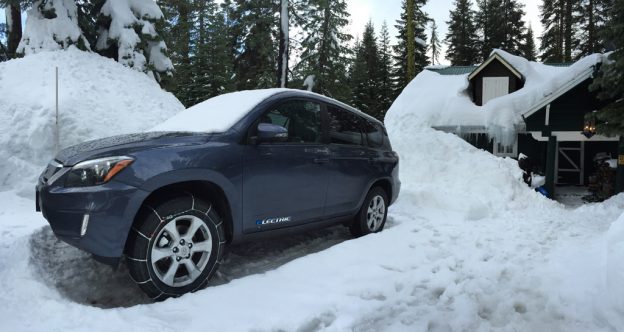January 2016. Sierra Nevadas, California.
This article was originally posted on the Transport Evolved website in January 2016.
We live in California’s Central Valley about 100 miles from beautiful spots in the Sierra Nevadas, and we try to get up there as often as possible. Our town sits just above sea level, so traveling to the Sierras involves a climb of 7000 feet. This could be a problem for EVs that have 80-100 miles of range and no options for rapid DC charging, especially in the winter.
This post addresses the following questions: How does the Rav4 EV handle winter outings in the mountains? How well does it drive in the snow? This post also relates another example for how rapid DC charging works for a typical drive.
This year we drove up into the Sierra Nevadas over the MLK holiday weekend to stay in Twin Bridges and go skiing. The map below shows our route, and the graph below it plots elevation along the route.
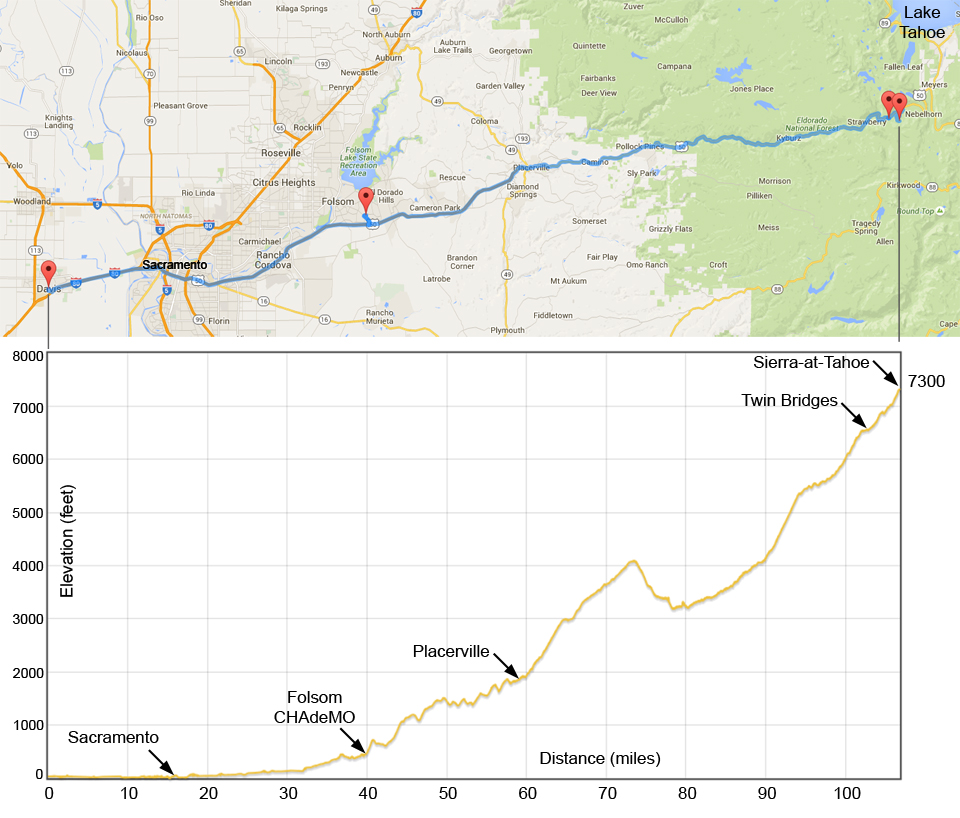
One important thing has changed since we last visited the Lake Tahoe region: JdeMO.
Last September Tony Williams installed Quick Charge Power’s JdeMO port on our 2012 Toyota Rav4 EV. We now use the growing network of CHAdeMO DC charging stations in California to fuel our car.
CHAdeMO is a direct current (DC) charging system that sends high voltage, high amperage direct current to the battery of your electric car; in the Rav4 a maximum of 386 volts and 125 amps. This reduces the amount of time required to charge your car to about 30 – 40 minutes.
Our destination was about 115 miles away. Not a problem in warm weather in the Central Valley. But cold weather decreases range, and steep climbs require extra energy – something that is true for all cars, gas or electric.
Based on info provided by Tony, I’d need an extra 1.8 kWh in the battery pack for each 1000 feet climbed, more to carry the extra weight of passengers and luggage, and more to drive in cold temperatures since the car uses energy from the traction battery to heat the battery pack (see text below to read Tony’s advice for calculating the energy needed to gain elevation). I calculated 2 kWh per 1000 feet, and with a 7000 foot climb ahead of me figured I’d need to add an extra 15 kWh to the battery pack along the way. I could achieve that with a 3 hour stop at a Level 2 charger along the way, or less than 30 minutes using CHAdeMO.
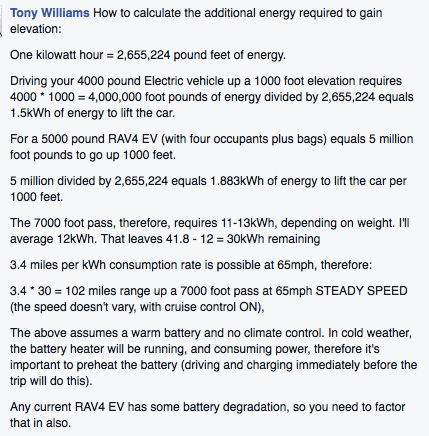
The number of CHAdeMO stations in California is expanding, but the CHAdeMO charging station in Folsom is currently the closest to Lake Tahoe (Author edit: remember this post was written in early 2016 – there are now many more DC charging stations). The Folsom station was 65 miles and 6000 feet elevation from my destination in Twin Bridges. Unless you’re driving a Tesla, that’s a trip you plan well.
I started from home with the Rav4 EV fully loaded with a family of 4, supplies for a winter weekend, and lots of food and drinks. The battery was charged to 95%, which in the Rav4 EV meant about 40 kWh in the pack. I stopped at the Folsom CHAdeMO station for 30 minutes and picked up 16 kWh. To be on the safe side I added 4 kWh in Placerville on a Level 2 charger. Starting with 40 kWh in the pack, plus the 20 kWh I picked up along the way, I had about 60 kWh for my trip.
The trip up to Twin Bridges was uneventful. The temperature dropped as we climbed, snow began falling as we drove above 4000 feet, and lots of traffic slowed us down – everybody had the same idea that this would be a good weekend for skiing.
We arrived in Twin Bridges with about 14 kWh in the pack, and the Guess-O-Meter (GOM) estimating we could drive another 38 miles. More on the GOM below.
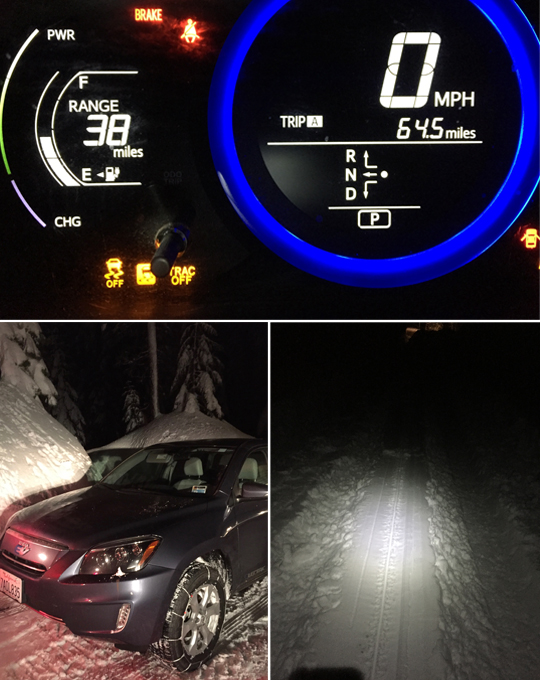
The house we rented for the weekend was on an unplowed road covered with about 12 inches of fresh snow –higher than the battery pack under my car. I stopped to put on chains, and while waiting my turn to drive up the road watched an all wheel drive BMW get stuck and sit there spinning its wheels. That driver made a common mistake: when the tires start slipping in snow you don’t want to floor the accelerator, it’s not going to help.
On a related note, EVs have instant torque that makes them fast, and I wondered if that torque would make the car prone to slipping in snow. Not at all. The front wheel drive Rav4 EV handled the snow like a champ – and it probably helped having an 850 pound battery pack sitting on the car’s frame.
The next day we drove up to Sierra-at-Tahoe for a day of skiing. The resort has one, count ’em 1, charging spot available for visitors: a 120V outlet with a single plug. You have to bring along your own mobile charging cord to use this charging spot so I came prepared.
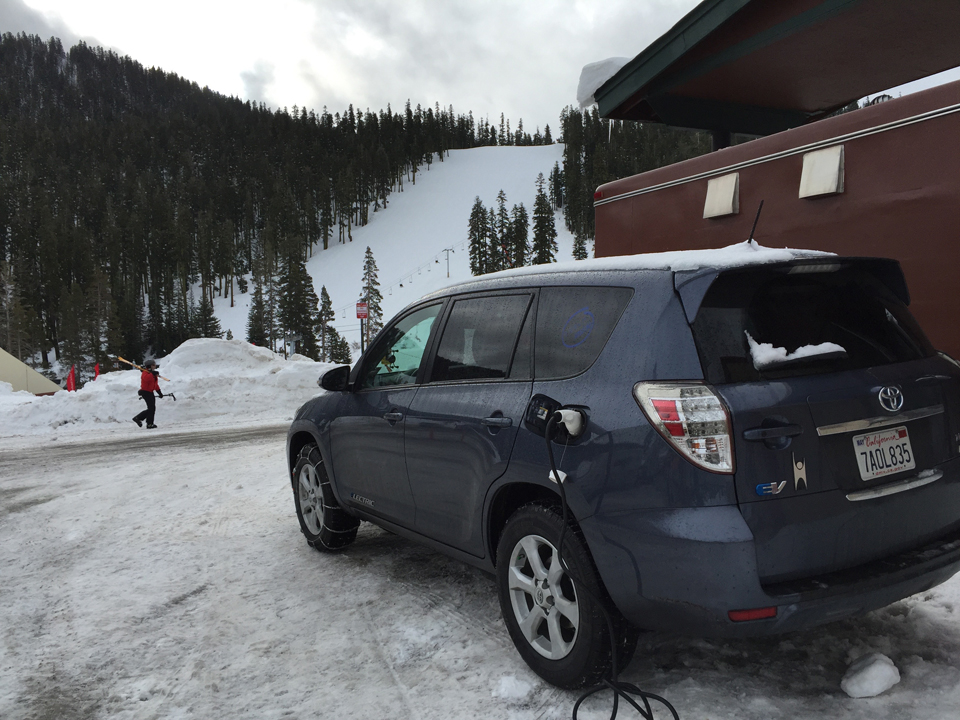
120 volts is not the ideal way to charge the Rav4 EV. It’s a trickle charge and takes insanely long. Over 7 hours the 120V line added just 6 kWh to the pack. A 240 volt line would have been nice, but I was happy the resort gave me a dollar’s worth of electricity in exchange for the lift ticket I bought. As an aside: I tried plugging into 120 volt outlets at our rental, but the outlets were not properly grounded and would not initiate a charge. These are the sorts of variables you want to keep in mind when planning a trip like this.
After several great days in the snow, it was time to head back down to the Central Valley. I had about 16 kWh to start my return trip. Even though the driving range estimate of my EV indicated just 35 miles, I knew 16 kWh was more than enough to drive 60 miles downhill. Why? A word on range estimates is warranted here.

The GOM: The Rav4 EV driving range estimate is called a Guess-O-Meter, or GOM, for good reason. The car computes a driving range estimate based on several variables starting with how much energy is stored in the pack, the efficiency of your past couple of trips, and the temperature of the battery pack. If your recent driving included steep inclines, or heavy-footed driving, or if the car is parked outside in cold weather, the estimate will be low. But if you’ve been driving on flat terrain in warm weather the estimate will be much higher. Either way, an important thing to keep in mind is that the amount of energy stored in the battery pack doesn’t change… just the car’s estimate of how far you might drive with that energy. The Rav4 EV’s GOM has been described this way: “The GOM is where you’ve been, not where you’re going.”
In the Rav4 EV we are stuck with technology from 2012…. things are moving fast in the EV world. But with 2½ years of experience driving the Rav4 EV, I knew 16 kWh was more than enough to get us down to Folsom, especially driving downhill. Just think about piloting a sled downhill: it doesn’t require onboard energy, just control. Better yet, when coasting downhill EV’s generate electricity that is stored in the battery pack, so I planned on making electrons.
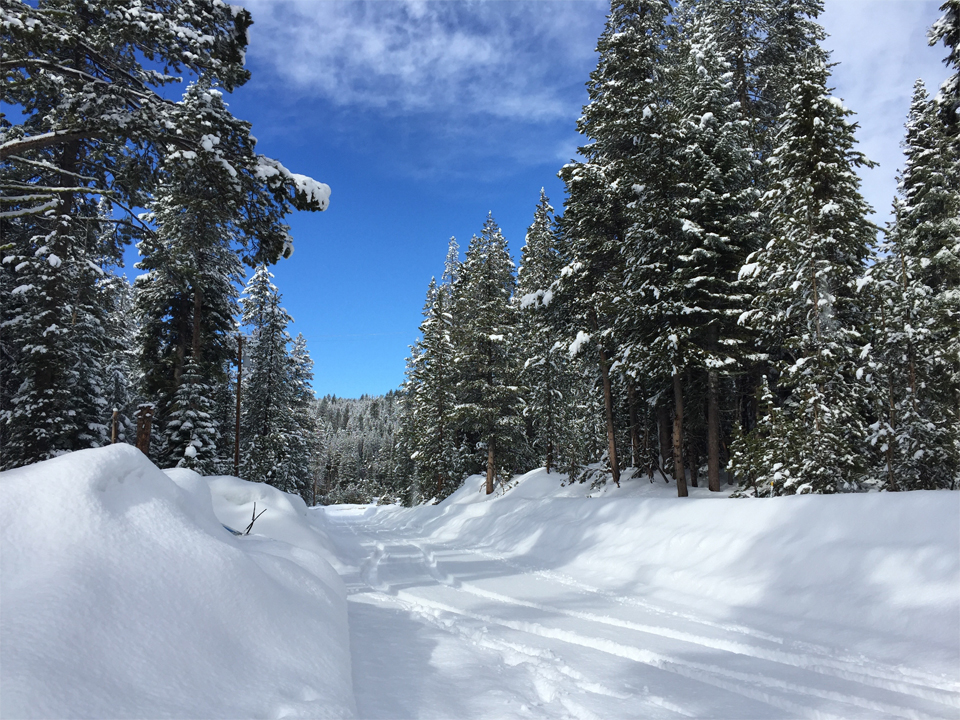
It was 32 degrees and there was a fresh layer of snow on the ground when we left Twin Bridges, so I kept the tire chains on till we reached the chain control check point on Route 50. After driving more than 60 miles we arrived to a sunny 65 degrees in Folsom with the GOM telling us we could drive a full 18 miles, with about 8 kWh remaining in the pack. I plugged into the CHAdeMO charging station for a quick charge and we drove home.
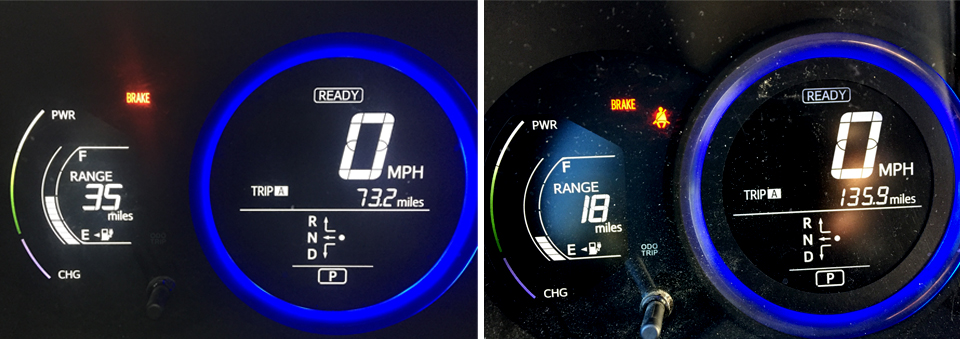
Toyota lacked the foresight to include a DC charging port on the 2012-2014 Rav4 EV. Lucky for us and other Rav4 EV owners, Quick Charge Power addressed this serious shortcoming by producing JdeMO. This DC charge port works flawlessly and has expanded the utility of our car. A trip up to the Tahoe region, or anywhere for that matter, takes far longer without DC charging.
There are a couple ways to approach driving longer distances in an electric car: You can have an electric car with a large battery that will drive you 200 or 300 miles – like a Tesla; You can drive an electric car with a rapid DC charging port – like a Tesla; or you can drive one of the growing number of EVs with 80 – 100 miles of range and a DC charging port. The Rav4 EV has an EPA rated range of 113 miles, add a DC charging port and you’ve got a useful car.
Nissan, BMW, Ford and VW have all announced, or already released, new versions of their electric cars that will have 25-30% greater range simply because of continual improvements in the energy density of Lithium ion batteries. If Toyota had continued development of the Rav4 EV we could be looking at similar improvements and a real-world, EPA-rated range over 140 miles.
Summary: The Rav4 EV has decent traction on snowy roads. The Rav4 EV is a good electric car with plenty of room for storage, great utility and decent range. With the addition of a CHAdeMO charging port the range and utility of the car is even better. And finally, effective DC charging infrastructure makes traveling a cinch.

